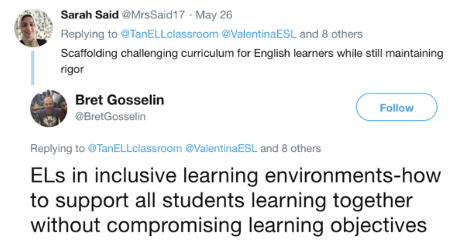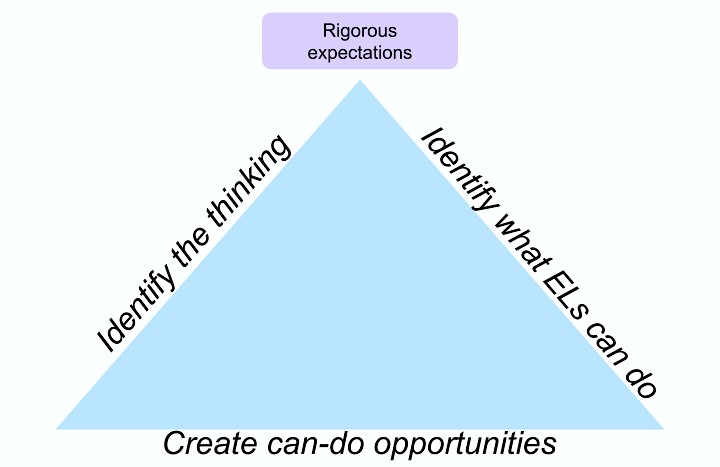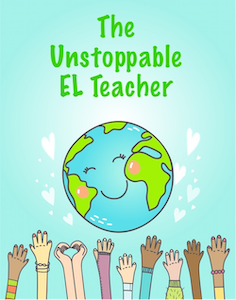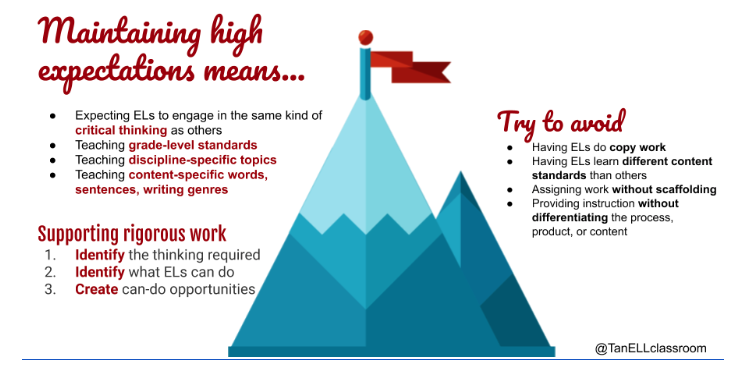3 Keys to Keeping the Rigor High for ELs
A MiddleWeb Blog
This is my second article in a year-long MiddleWeb writing partnership with EL education leader Valentina Gonzales, here at The Unstoppable EL Teacher blog.
To make our posts as helpful as we can, we surveyed our Twitter PLN to ask educators working with English learners what topics they would like for us to explore with them in this space.
The suggested topics include:
- Assessment
- Instruction
- SLIFE
- Learning Support
- Community Engagement
Both Sarah Said and Bret Gosselin asked similar questions: How can we support English Learners as they engage in a challenging, rigorous curriculum?

There are two things I recommend:
- Focus on the thinking
- Differentiate everything else
Focus on the thinking
The temptation for many teachers who have rigorous content objectives is to have ELs do a different task that is more manageable. However, an EL’s language proficiency is not an indicator of intelligence. We have to remember that ELs are capable of doing the same kind of thinking that non-ELs can do. They might just have to temporarily show it differently than their peers.
WIDA (formerly World-Class Instructional Design and Assessment) found that the types of language used most often in academic and business settings were recount, explain, argue, and discuss. WIDA decided to group these four forms of language into what they call Key Uses as they represent the keys to academic success (Board of Regents of the University of Wisconsin System, 2016; Lundgren, 2015).
The 3 Steps to Maintaining a High Level of Academic Rigor
There are three steps I use to maintain a high level of academic rigor:
- Identify the thinking required
- Identify what ELs can do
- Create can-do opportunities
Instead of having ELs do a different task with a simpler content objective, give ELs a task that helps them do the thinking that the task requires. For example, let’s take Kham, a middle school newcomer whose native language is Lao.
In his art class, Kham’s teacher wants him to compare two pieces of work. Even though he is beginning his English-language journey, he can still compare the two pieces of art.
Identify the thinking required: Kham needs to explain the similarities and differences between two pieces of artwork.
Identify what ELs can do: Kham can use Google Translate, and he can read and write in basic English with help.
Create can-do opportunities: Kham can compare and contrast the differences with physical labels, like sticky notes.
In this example, Kham’s art teacher gave him sticky notes to compare how colors are used in each piece of art. She provided him with descriptive words associated with colors such as bright, dark, light, heavy, shadows, radiant, etc.
I provided him with comparison words such as more, less, the same, and taught him to add “er” at the end of some of these adjectives to show comparison. That was a language learning experience also because in Lao, there are no suffixes such as “er,” “est,” or “ier” to show comparison. The Lao language uses only articles and classifiers to compare.
Kham then translated adjectives given by the art teacher into Lao and wrote them on sticky notes. He placed the two pieces side-by-side and compared features such as brightness, diversity of colors, and the use of shadows. As he analyzed the pieces, he placed the sticky notes onto the copies of the artwork to communicate the differences he saw. This process continued as he compared other artistic concepts such as shape, texture, and kinds of objects.
Once he was done, Kham wrote simple English sentences using the sticky notes to guide his thinking. I provided sentence stems to scaffold his written language.
In this example, Kham still compared two pieces of art like everyone else. He still engaged in the same kind of thinking: comparing. How he communicated his ideas was different, yet appropriate for his level of English. This project adaptation created an opportunity for Kham to show what he noticed about the two pieces of art.
Differentiate everything else
In The Differentiated Classroom, Carol Ann Tomlinson offers a simple framework for differentiation (2005). Her framework identifies 3 different elements of a lesson that can be differentiated, including:
- Content – the topic that students are studying.
- Process – how students are engaging with the content.
- Product – what students will produce to demonstrate understanding.
With this framework, we can change either the content, the process, or the product and still keep the intellectual rigor high.
In Kham’s example, we kept the rigor of comparing two pieces of art the same but differentiated the process and the product. Here’s how that looks in Carol’s framework:
- Content: No differentiation. The two pieces of art were the same for all students.
- Process: The teacher provided guided instruction to Kham by giving him specific vocabulary words while the other students did not require it.
- Product: While other students produced a series of paragraphs, Kham arranged the sticky notes according to what he noticed. Then we wrote simple sentences.
Although we differentiated two of the three components of Kham’s assignment, we could also just focus on one if that would be more manageable. We don’t have to differentiate all of the components of a lesson, but not differentiating at all prevents ELs from reaching the highest level of an intellectual standard.
The diagram below represents this three-part framework to differentiating instruction. To keep the rigor high, we can’t just expect ELs to reach it, we have to help them climb.

“High challenge, high support”
Luciano Mariani shared a concept of high challenge, high support to help explain how differentiation at an advanced level should work (1997). Many content teachers feel that differentiation makes the task easier. They (understandably) want to keep the challenge high. Differentiating does not shrink the size of the mountain. It’s about making getting to the top more possible.
To meet these high expectations, we as language development teachers need to offer an equal degree of high support. We need to show our colleagues that differentiation makes a task possible, not easier. Kham engaged in the same level thinking as his peers – identifying and comparing complex aspects of art. We just made the comparing and contrasting more visible, thus making the task more possible.
Therefore, our real job is to convince our co-teachers that they’re right to want to keep the rigor high. We’re right there with them because we also want to close the achievement gap. But just expecting a seed to grow won’t produce a forest. It requires constant support, care, and attention. The seed will do the work of growing and digging its roots deeper once it has the conditions needed for growth.
Convince your co-teachers that if they’re willing to help make this work, you are too. Show them easy ways to differentiate lessons and modify the products students create.
Resources
Board of Regents of the University of Wisconsin System (2016). WIDA can do descriptors: Key uses edition 9-12.
Lundgren, C. (2015). WIDA: Introducing the Key Uses of Academic Language. Retrieved from https://www.slideshare.net/MELEdConference/wida-introducing-the-key-uses-of-academic-language [[[ I pasted in a live version of this url, but it did’t stay alive ]]]
Mariani, L. (1997). Teacher support and teacher challenge in promoting learner autonomy. Perspectives, 23(2). Retrieved August 18, 2013 from http://www.learningpaths.org/papers/papersupport.htm
Tomlinson, C. A. (2005). The Differentiated classroom: Responding to the needs of all learners. New Jersey: Pearson.



































